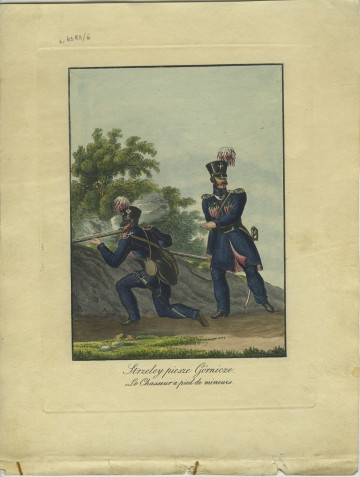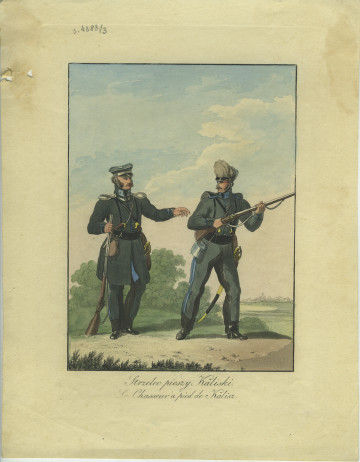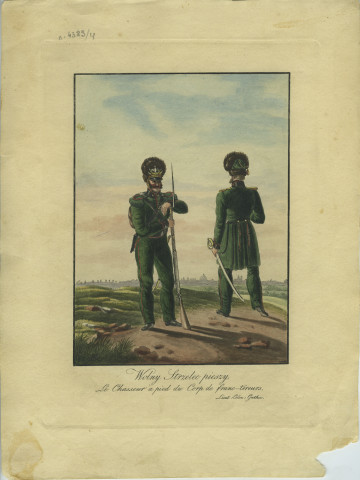
Mining Corps Foot Riflemen, Le Chasseur a pied de mineurs
XIX century
Castle Museum in Łańcut
Part of the collection: Grafika
The idea of creating riflemen's units in the Polish Army is attributed to Tadeusz Kościuszko. During the American War of Independence, he observed the effectiveness of volunteer units composed of hunters and farmers armed with hunting rifles, who inflicted significant losses on British forces. Similarly, in Poland, these units recruited hunters, foresters, and especially the Kurpie people, renowned in the Polish-Lithuanian Commonwealth for their shooting skills. Kościuszko wrote a manual for training riflemen, published by the Military Commission on 20 April 1791. Similar infantry units were formed during the November Uprising, with sizes equivalent to regular infantry battalions. Riflemen were equipped with firearms of various origins, usually hunting rifles. The 7th Kraków Battalion of Riflemen was formed in Kraków Voivodeship in January 1831, incorporating forest corps units. The battalion participated in the Battle of Chotcza Góra on 10 September 1831, known as the last battle of the November Uprising, as it took place two days after the fall of Warsaw, the most important stronghold in the Polish-Russian war. The Battle of Chotcza Góra was one of the largest engagements fought by General Samuel Różycki against the Russian corps of General Rüdiger. In this battle, hundreds of Polish soldiers lost their lives.
This graphic is part of the series Ubiory Wojska Polskiego z roku 1831 (Uniforms of the Polish Army from 1831), based on drawings by Jan Feliks Piwarski (1794–1859), a painter, graphic artist, curator of the Print Room at the University of Warsaw, professor at the Warsaw School of Fine Arts, and one of Poland's first lithographers. Piwarski was an eyewitness to the Warsaw uprising. The author of the engraving is Fryderyk Krzysztof Dietrich (1779-1847), a German-born engraver who was associated with Poland since 1819. For many years, he operated a print workshop in Warsaw with his son, producing works highly regarded for their artistic quality. The series included 30 engravings, which Dietrich hand-coloured with the help of his son and, later, another engraver. Gazeta Warszawska in 1831 noted that "Mr. Dietrich has begun publishing depictions of our army’s uniforms, highly sought after abroad." The engravings were sold by Antoni Dal Trozzo in Warsaw, and Dietrich dedicated them as a token of respect to General Jan Zygmunt Skrzynecki.
This piece was acquired from the Lubomirski family of Przeworsk.
Daniel Reniszewski
Lit: H. Widacka, Dietrichowie rytownicy warszawscy, Warszawa 1989.
Author / creator
Object type
grafika/rysunek
Technique
litografia podmalowana
Material
paper
Creation time / dating
Creation / finding place
Owner
Muzeum - Zamek w Łańcucie
Identification number
Location / status

XIX century
Castle Museum in Łańcut

XIX century
Castle Museum in Łańcut

XIX century
Castle Museum in Łańcut
DISCOVER this TOPIC
Museum of King Jan III's Palace at Wilanów
DISCOVER this PATH
Educational path